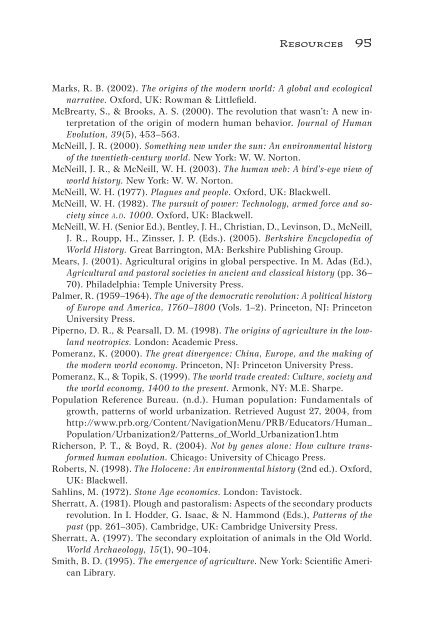This Fleeting World
This Fleeting World
This Fleeting World
Create successful ePaper yourself
Turn your PDF publications into a flip-book with our unique Google optimized e-Paper software.
Resources 95<br />
Marks, R. B. (2002). The origins of the modern world: A global and ecological<br />
narrative. Oxford, UK: Rowman & Littlefield.<br />
McBrearty, S., & Brooks, A. S. (2000). The revolution that wasn’t: A new interpretation<br />
of the origin of modern human behavior. Journal of Human<br />
Evolution, 39(5), 453–563.<br />
McNeill, J. R. (2000). Something new under the sun: An environmental history<br />
of the twentieth-century world. New York: W. W. Norton.<br />
McNeill, J. R., & McNeill, W. H. (2003). The human web: A bird’s-eye view of<br />
world history. New York: W. W. Norton.<br />
McNeill, W. H. (1977). Plagues and people. Oxford, UK: Blackwell.<br />
McNeill, W. H. (1982). The pursuit of power: Technology, armed force and society<br />
since a.d. 1000. Oxford, UK: Blackwell.<br />
McNeill, W. H. (Senior Ed.), Bentley, J. H., Christian, D., Levinson, D., McNeill,<br />
J. R., Roupp, H., Zinsser, J. P. (Eds.). (2005). Berkshire Encyclopedia of<br />
<strong>World</strong> History. Great Barrington, MA: Berkshire Publishing Group.<br />
Mears, J. (2001). Agricultural origins in global perspective. In M. Adas (Ed.),<br />
Agricultural and pastoral societies in ancient and classical history (pp. 36–<br />
70). Philadelphia: Temple University Press.<br />
Palmer, R. (1959–1964). The age of the democratic revolution: A political history<br />
of Europe and America, 1760–1800 (Vols. 1–2). Princeton, NJ: Princeton<br />
University Press.<br />
Piperno, D. R., & Pearsall, D. M. (1998). The origins of agriculture in the lowland<br />
neotropics. London: Academic Press.<br />
Pomeranz, K. (2000). The great divergence: China, Europe, and the making of<br />
the modern world economy. Princeton, NJ: Princeton University Press.<br />
Pomeranz, K., & Topik, S. (1999). The world trade created: Culture, society and<br />
the world economy, 1400 to the present. Armonk, NY: M.E. Sharpe.<br />
Population Reference Bureau. (n.d.). Human population: Fundamentals of<br />
growth, patterns of world urbanization. Retrieved August 27, 2004, from<br />
http://www.prb.org/Content/NavigationMenu/PRB/Educators/Human_<br />
Population/Urbanization2/Patterns_of_<strong>World</strong>_Urbanization1.htm<br />
Richerson, P. T., & Boyd, R. (2004). Not by genes alone: How culture transformed<br />
human evolution. Chicago: University of Chicago Press.<br />
Roberts, N. (1998). The Holocene: An environmental history (2nd ed.). Oxford,<br />
UK: Blackwell.<br />
Sahlins, M. (1972). Stone Age economics. London: Tavistock.<br />
Sherratt, A. (1981). Plough and pastoralism: Aspects of the secondary products<br />
revolution. In I. Hodder, G. Isaac, & N. Hammond (Eds.), Patterns of the<br />
past (pp. 261–305). Cambridge, UK: Cambridge University Press.<br />
Sherratt, A. (1997). The secondary exploitation of animals in the Old <strong>World</strong>.<br />
<strong>World</strong> Archaeology, 15(1), 90–104.<br />
Smith, B. D. (1995). The emergence of agriculture. New York: Scientific American<br />
Library.


